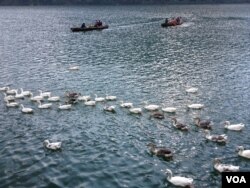From low-lying plains to high mountains, many of India’s lakes and rivers have become heavily polluted. But in some places like the hill town of Nainital, in northern Uttarakhand state, a local initiative to reverse the damage is paying off.
On a clear October day, Naini Lake shimmers in the afternoon sun as boatmen row tourists across the hill resort’s prime attraction nestled amid lush, pine-clothed Himalayan peaks.
Cutting his oars deftly through the waters, boatman Lakshman Singh points proudly to fish swimming just beneath the surface. That was not the case some years ago.
“You could see slime in many places, and garbage floating in the water. Customers used to tell us this lake is so dirty,” he recalled.
Intense development
By the mid nineteen nineties, the 20-meter-deep lake had begun resembling a dirty pond as it choked on the town’s waste brought by more than 60 sewer drains.
Local resident Ajay Rawat, who is an academic and environmental activist, relates how relentless construction of new hotels and resorts on scenic hill slopes intensified the problem.
“Unfortunately when the builder culture came to Nainital, to save their costs, these builders were disgorging their rubble into the drains and ultimately when the rain came it cascaded down to the lake. That was one of the most important causes of pollution,” he said.
Nearly two decades ago, Rawat, the man who has been at the forefront of the campaign to clean up the lake, petitioned the Supreme Court on the urgent need to address the problems that were threatening the hill town’s source of water and its fragile eco system.
Soon after, the local administration swung into action to revive the lake, using modern technology and the help of scientists from G.B. Pant University. The efforts are finally showing results.
Aquatic revival
Deweeding has been carried out. A bio manipulation technique has been used to reintroduce indigenous fish species that had virtually disappeared. This helped revive aquatic life in the lake.
“Because of the deteriorated lake water, Mahasir [fish species] was not able to survive," said Inderjeet Singh, dean of fisheries at G.B. Pant University of Agriculture and Technology. "Being the native fish, it is more suitable for that environment. We removed the unwanted fishes.”
Meanwhile, massive pumps continue to throw oxygen into the water, said Harpinder Singh Randhawa, of Global Aqua Treatment Technology, who heads an aeration project. “Pumps are running for 12 to 13 hours, sometimes 14 hours. At present the bottom is clear, but careful monitoring is done," he said.
But scientific inputs were not enough. With college students at the forefront, the lake’s revival turned into a kind of movement and for over a decade, young students went for lake-cleaning every Sunday.
“We used to take out whatever was thrown in the lake, plastics, at times animals, like dogs and cats we have removed also,” said Rawat as he lamented that some people still litter the lake.
The revival of the lake has boosted tourism and increased incomes, especially of boatmen who row tourists around industriously.
Content community
And it has made residents happy, like 35-year-old Tej Singh, who grew up in Nainital.
“The lake is definitely cleaner than it used to be. Earlier its color had changed. Now the water looks much better,” he said.
With Nainital lying at the nucleus of a 200-square-kilometer hilly region with several other Himalayan lakes, attention is now focussed on cleaning up the other water bodies.
A massive lake lying in the midst of a neighboring hill resort, Bhimtal, is getting similar attention. A restaurant that had been built on a tiny island in the lake, and disgorged its waste into the water, has been shut and replaced with a state-of-the art aquarium.
As India confronts the gigantic task of combating pollution in its waterways, environmentalists are calling for more such grass root initiatives.
Pointing out that a multi-billion-dollar, federally-funded project to clean up the country’s largest river, the Ganges, has failed to make headway a quarter century after it was launched, they say campaigns involving local communities often can show faster and better results.


